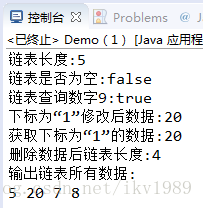范例:
class Link {
class Node {
private Node next;// 下一个节点
private Object data;// 数据
// 构造方法
public Node(Object data) {
this.data = data;
}
// 1.节点的增加
// 第一次调用:this=Link.root
// 第二次调用:this=Link.root.next
public void addNode(Node newNode) {
if (this.next == null) {// 如果下一节点为空,新节点为当前对象的下一节点
this.next = newNode;
} else {
this.next.addNode(newNode);
}
}
// 2.数据查询
public boolean containsNode(Object data) {
if (data.equals(this.data)) {
return true;
} else {
if (this.next != null) {
return this.next.containsNode(data);
} else {
return false;
}
}
}
// 3.修改节点数据
public void setNode(int index, Object data) {
if (Link.this.foot++ == index) {
this.data = data;
} else {
this.next.setNode(index, data);
}
}
// 4.节点数据查询
public Object getNode(int index) {
if (Link.this.foot++ == index) {
return this.data;
} else {
return this.next.getNode(index);
}
}
// 5.删除节点
// 第一次调用 previous=Link.root;this=Link.root.next
// 第二次调用 previous=Link.root;this=Link.root.next.next
public void removeNode(Node previous, Object data) {
if (data.equals(this.data)) {
previous.next = this.next;
} else {
this.next.removeNode(this, data);
}
}
// 6.对象数组
public void toArrayNode() {
Link.this.retArray[Link.this.foot++] = this.data;
if (this.next != null) {
this.next.toArrayNode();
}
}
}
// ==============以上是内部类==============
private Node root;// 根节点
private int count;// 计数器
private int foot;// 定义脚标
private Object[] retArray;// 设置对象数组
// 1.增加数据
public void add(Object data) {
if (data == null) {// 如果数据为空,退出
return;
}
Node newNode = new Node(data);// 数据打包
if (this.root == null) {// 如果根节点为空
this.root = newNode;// 新节点为根节点
} else {
this.root.addNode(newNode);
}
this.count++;
}
// 2.查询数据
public boolean contains(Object data) {
if (data == null || this.root == null) {
return false;
} else {
return this.root.containsNode(data);
}
}
// 3.数据修改
public Object set(int index, Object newData) {
if (index > this.count) {// 数组下标越界,退出
return null;
}
this.foot = 0;// 每次修改,小标归零
this.root.setNode(index, newData);
return newData;// 修改成功返回修改后的数据
}
// 4.获取数据
public Object get(int index) {
if (index > this.count) {// 数组越界
return null;
}
this.foot = 0;// 获取数据时候,下标归零
return this.root.getNode(index);
}
// 5.数组长度
public int length() {
return this.count;
}
// 6.数组是否为空
public boolean isEmpty() {
return this.count == 0;
}
// 7.删除数据
public void remove(Object data) {
if (this.contains(data)) {// 当前对象是否包含被删除数据
if (data.equals(this.root.data)) {// 删除是否根节点的数据
this.root = this.root.next;// 根节点的下一节点是根节点
} else {
this.root.next.removeNode(this.root, data);// 不是根节点,从根节点的下一节点开始判断
}
}
this.count--;
}
// 8.对象数组
public Object[] toArray() {
if (this.root == null) {// 根节点是否为空,为空则返回null
return null;
}
this.foot = 0;// 脚标归零
this.retArray = new Object[this.count];// 开辟数组
this.root.toArrayNode();
return this.retArray;
}
public static void print(Object[] data) {
for (Object x : data) {
System.out.print(x + " ");
}
}
}
public class Demo {
public static void main(String[] args) {
Link all = new Link();
all.add(5);
all.add(6);
all.add(7);
all.add(8);
all.add(9);
System.out.println("链表长度:" + all.length());
System.out.println("链表是否为空:" + all.isEmpty());
System.out.println("链表查询数字9:" + all.contains(9));
System.out.println("下标为“1”修改后数据:" + all.set(1, 20));
System.out.println("获取下标为“1”的数据:" + all.get(1));
all.remove(9);// 删除数据
System.out.println("删除数据后链表长度:" + all.length());
System.out.println("输出链表所有数据:");
Link.print(all.toArray());
}
}








 本文介绍了一个简单的链表数据结构实现,包括添加、查询、修改、删除等基本操作,并通过一个示例程序展示了如何使用该链表类进行数据管理。
本文介绍了一个简单的链表数据结构实现,包括添加、查询、修改、删除等基本操作,并通过一个示例程序展示了如何使用该链表类进行数据管理。
















 587
587

 被折叠的 条评论
为什么被折叠?
被折叠的 条评论
为什么被折叠?








